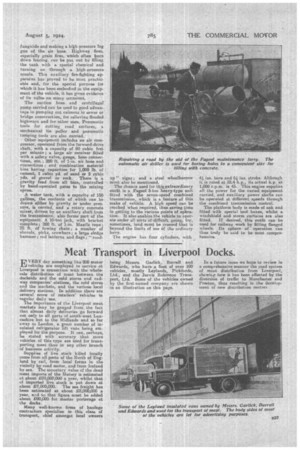Meat Transport in Liverpool Docks.
Page 19

If you've noticed an error in this article please click here to report it so we can fix it.
V VERY day something like 200 motor
A 11 vehicles are employed in service at Liverpool in connection with the wholesale distribution of meat between the dockside and the cold stores and railway companies' stations, the cold stores and the markets, and the various local delivery stations. In addition there are several score of retailers' vehicles in regular daily nse.
The importance of the Liverpool meat markets may be gauged from the fact that almost daily deliveries go forward not only to all parts of south-west Lancashire but, to the Midlands and so far away as London, a great number of insulated refrigerator lift vans being employed for the purpose. It can, perhaps, be stated with accuracy that more vehicles of this type are used for transporting meat than in any other branch of business activity. Supplies of live stock killed locally come from all parts of the North of England by rail, from local farms in the vicinity by road motor, and from Ireland by sea. The monetary value of the dead meat imports of the Mersey is estimated at about £20,000,000 a year, whilst that of imported live stock is put down at about £7,000,000. The sea freight has been estimated at about £2,000,000 year, and to that figure meet be added about £90,009 for master porterage at the docks.
Many well-known firms of haulage contractors specialize in this class of transport, chief amongst local owners being Messrs. Garlick, Burrell and Edwards, who have a fleet of over 100 vehicles, mostly Leylands, Pick fonts, Ltd., and the Jarvis Robinson Transport, Ltd. Some of the vehicles owned by the first-named company are shown in an illustration on this page.
In a future issue we hope to review in a comprehensive manner the road system of meat distribution from Liverpool, shcwing how it has been affected by the diversion of traffic to Manchester and Preston, thus resulting in the development of new distribution centres






























